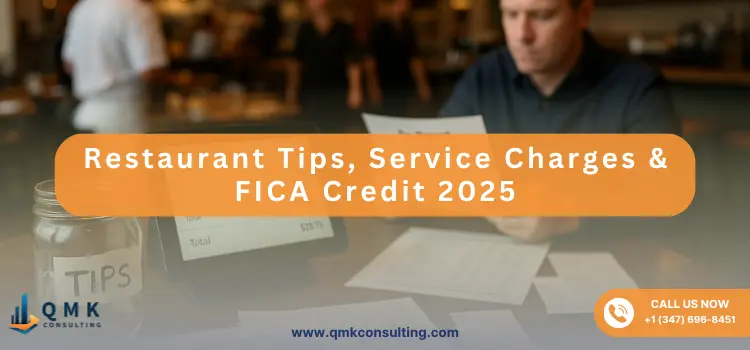
October 24, 2025 |Tax Preparation Services


If you run a restaurant or franchise, tips are more than a line on the guest check—they’re payroll, tax, and cash-flow drivers that affect margins every single pay period.
In 2025 the IRS continues to emphasize accurate tip reporting, the difference between tips vs. service charges, and proper use of the FICA Tip Credit (Form 8846). Here’s a practical, plain-English guide to keep your locations compliant—and to turn good records into real savings.
Quick truth to anchor everything: employees must report tip income to the employer (with a $20/month exception), and employers must treat tips correctly for income tax withholding and FICA. That has not changed. (IRS)
The IRS draws a bright line between tips (discretionary payments) and service charges (mandatory amounts added by the employer). Only true tips can count toward the FICA Tip Credit; service charges are treated as wages—with full payroll tax withholding—and do not qualify for the credit.
IRS factors for a valid tip (from Rev. Rul. 2012-18):
If any factor is missing—e.g., an automatic 18% “gratuity” for parties of six—then it’s a service charge. Amounts you distribute from service charges are wages, not tips, and must be run through payroll.
Action for operators
The IRS’s Service Industry Tip Compliance Agreement (SITCA) is a voluntary program intended to replace older TRAC/TRDA agreements and to leverage modern POS, timekeeping, and payment systems for better tip compliance. SITCA has been rolled out via proposed guidance and IRS bulletins since 2023; many operators are evaluating it alongside internal tip policies. It does not change the basic rule that all tips are taxable and must be reported.
Should you consider SITCA?
Whether or not you adopt SITCA, the day-to-day blocking and tackling—clean tip records, accurate payroll treatment, and sound policies—remains essential. For in-house training, the IRS “Tips on Tips” guides for employers and employees are still helpful primers.
If tipping is customary at your food or beverage establishment, you may be able to claim a dollar-for-dollar credit for the employer share of Social Security and Medicare taxes you pay on certain reported tips. The credit is taken on Form 8846 and flows to the general business credit.
How it works—owner’s view
Documentation you’ll need
Don’t leave retro money on the table: Amended returns can be used to claim prior-year credits when records support it.
A. Train & remind
Employees who receive $20 or more in tips in a month must report them to you by the 10th of the next month (or the next business day). Reinforce this in orientation and pre-shift.
B. Separate the streams in your GL
C. Reconcile charge tips and cash tips
Use your POS closeout to match charge tips to merchant statements; use manager-signed cash-tip logs for cash-heavy outlets.
D. Don’t forget Form 8027
"Large food or beverage establishments" must complete Form 8027 on a yearly basis to record revenues and tip amounts.
Calling a service charge a “tip.”
Fix the language in your POS and on guest checks. Reclassify amounts in your GL and run any employee distributions through payroll.
Counting service charges toward the tip credit.
Remove them. Only true tips count for Form 8846.
Late or missing tip reports.
Implement a POS prompt at clock-out or a monthly digital reminder (due by the 10th). Keep a signed log.
No 8027 process at large establishments.
Designate a manager to assemble annual receipts/tips by location and maintain a support binder.
Assuming new laws eliminated the tax on tips.
Even with recent federal changes discussed in the news, payroll withholding and reporting rules for tips still apply; employees must report tips, and employers must withhold and pay FICA. Monitor IRS guidance for any return-level deductions employees may claim, but your payroll compliance does not change.
New York City-based QMK Consulting is an accounting firm that specializes in restaurant and franchise accounting. We support operators:
If you want tip compliance that just works—and puts money back in your business via the credit—we’re here.
Get a free Profit & Cash Flow Analysis by our experts. Book time with Mohamed Karmous, Franchise Accounting Expert and Restaurant Accounting Advisor at QMK Consulting. We’ll review your tip policies, payroll setup, and credit opportunity—then hand you a simple plan to protect profit and cash across every location.
This post is not legal or tax advice; rather, it is general information. Always double-check details with your tax advisor and the latest IRS publications.